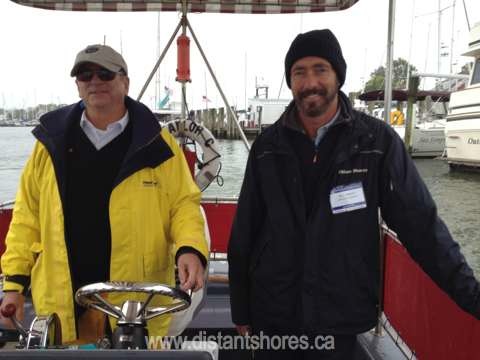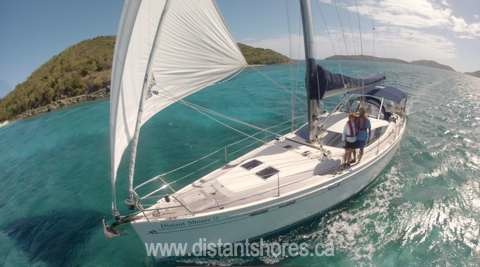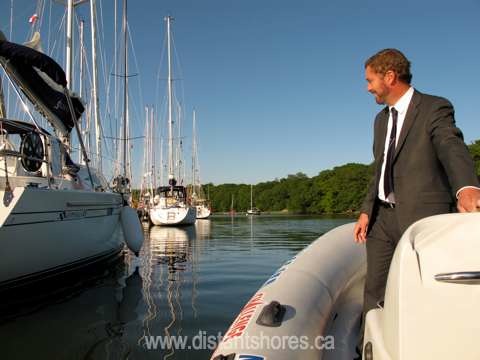Sailing Clothing for Tropics

Paul keeping cool in the tropics
Last week Paul and I went from wearing as little as possible to keep cool on the boat in the tropics to wearing hats, gloves, sweaters and jackets at the Annapolis Sailboat Show in Annapolis MD near Washington DC on the east coast of the USA.

Paul on the ferry at the Annapolis Sailboat Show dressed for October weather
When long-distance cruising and living aboard it is important to have clothes for all climates and occasions, yet it is a common mistake to bring too many clothes. When travelling and living afloat you do not need the extensive wardrobe you do when working and living ashore. Life is much more casual and, since you are not seeing the same people every day, you don’t need such a variety of outfits. Then there is the question of space, which is always limited, so it is best to choose clothing that you can mix and match together easily.
For the last two seasons we have been doing most of our cruising in tropical climates so the clothes we keep easily accessible are for hot weather. Our cold weather wardrobe, used when cruising in Scandinavia, the UK, Holland and Germany, is now in deep storage but was good to have onboard for our recent flight to the Annapolis Sailboat Show where we would have frozen otherwise.
We find the most comfortable fabric to wear in hot climates is a cotton-polyester blend. It doesn't wrinkle, is cool and absorbent but moisture wicks away and it dries quickly. It's great if you have to do laundry by hand since it drip-dries nicely, especially in a trade wind. We find 100% cotton is too absorbent; it always feels clammy to us in really hot weather. It also wrinkles badly and tends to fade quickly in strong sunshine. It doesn't seem to be as hard wearing as cotton-polyester either. There are also lots of high-tech wicking fabrics popular with tropical cruisers today too. But what is really important is that the clothes you pack are what YOU are comfortable wearing and allow you to do the job at hand.
In many countries that we have visited outside North America, people dress more formally to go to town for simple chores such as grocery shopping. If you show up in shorts and a T-shirt, it is considered disrespectful. When Paul and I go ashore, we “dress to belong”, especially if we are clearing into the country. You can really get off to a bad start if a customs official thinks you are not being respectful. Paul shaves and trims his beard and wears long pants even if it's hot and a nice shirt; I tie back my long hair and put on a skirt or sun dress, then off we go.

Sheryl keeping cool in a light sundress
Our friend cruising friend, Elizabeth, said wearing her “missionary dress” opened a lot of doors for her. This was an ankle-length, high-necked dress. She found when she wore it in the Caribbean, that the local women felt more comfortable with her. People invited her to their homes and she even got better prices at the local market because she was “obviously a god-fearing woman”. Having known Elizabeth for a number of years, Paul and I thought this was quite hilarious.
As a woman, I also discovered that wearing a dress is much more comfortable when the heat and humidity are severe. It's healthier too; wearing confining clothing in the heat (or sitting in a damp bathing suit) allows bacteria to incubate in your groin causing heat rashes and painful urinary tract infections. For the same reason, you should never wear nylon underpants in the tropics; cotton is more breathable therefore better for your well-being and comfort.
For passage-making in the tropics, we have several sets of warm clothes because at night or in bad weather you seem to need warm clothes. Sweat suits and fleece are great because you can move around easily in them, they are comfortable under your foul weather gear and you can wear them as pajamas when you're off watch. If you're called on deck in an emergency, you can jump out of your sleeping bag and still be decently dressed!

Sailing in the BVI where warm rain showers usually pass quickly
Foul weather gear should be comfortable and lightweight for tropical cruising as well as easy to move in so you can handle lines and sails. It should also be easy to get in and out of. If it's not, you probably won't put it on as often as you need to. If you get a douse of saltwater, your clothes will never dry and, before you know it, your teeth will be chattering.
Foul weather gear doesn’t need to be expensive. It just has to keep you dry. We give ours lots of ventilation by hanging them in the ventilated wet locker onboard Distant Shores II. Whenever we get the chance, we give them a fresh water rinse and a little air and sunshine to keep them fresh. We also keep a set of lightweight nylon rain gear for wet rides in the dinghy or if rain is expected when we are ashore. They roll up in their own compact little pouches and are easy to store in our tote bag or backpack. But often the rain and temperature is so warm in daytime we just enjoy getting cooled off in the shower and quickly air dry.
One winter when we got work ashore in Gibraltar, my mother shipped Paul two suits which we’d left at home (I had enough dresses with me) and we have kept good clothing on board, as well as our briefcases, ever since. Opportunities to work in other countries are a great way to gain insights into a new culture, make some interesting friends as well as adding some dollars to the cruising kitty.

Paul suitably attired for a banquet dinner for the annual Southerly Regatta in England
We keep several sets of dress clothing since we are often invited to local events that require it. In southern Spain the ex-patriot community frequently host formal parties and in Bermuda many restaurants require that men wear dinner jackets (but not ties... Paul asked, but they said “Oh no! That would be too hot”!!??).

Nice to have a few sets of dressy clothes for evenings out
We have a couple of nice hanging lockers on the boat where we hang our dress clothing and long sleeved shirts which we wear a lot for sun protection.
We store most of our other clothes – collared golf shirts (they protect your neck from the sun), T-shirts, shorts and bathing suits, etc. folded on shelves in well ventilated lockers in our forward cabin. They take up less space this way and aren't as likely to chafe as when they are swinging on hangers in a hanging locker. If you fold them carefully, you won't need to iron them.
Sun hats are important parts of our sailing wardrobe and for many years we have been fans of Tilley Hats which stay strapped on in the wind, have a secret pocket, float if you accidentally drop them overboard and are so long-wearing they have a lifetime guarantee.

Paul wearing his Tilley hat and long-sleeve wicking sailing shirt
Footwear consists of boat shoes (and boots for cold rainy weather) to protect our feet on board, sandals for walking around town, Crocs or water shoes for dinghy exploring and one pair of dress shoes each.
You really don't need a lot of clothing as a liveabaord sailor but what you do store onboard must make you feel good, protect you from the sun, not get caught easily when underway, allow you “to belong” ashore, and give you the option to attend a variety of social activities.
How about you? What's your clothing strategy when sailing?